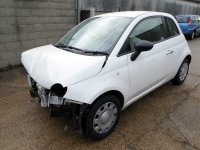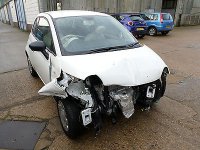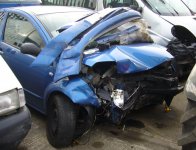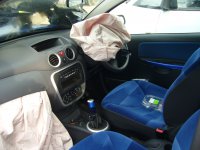I know, the dent in the boot in the Panda is tiny to be fairBetter your Panda than your wife.
OK, this one is personal, I'll admit - LadyKitching had a bad head on smash a few years back and very nearly lost her life.
Fortunately it was a newish, original, well maintained car; the airbags & pretensioners did what they were supposed to and she was driving at 28mph.
She spent the night after the accident in the ICU connected to a heart monitor. It was a very, very close call.
Sometimes having 99% of the original crash protection might just be 1% too little.
Technical Banging out dent in spare wheel well
- Thread starter typecastboy
- Start date
-
- Tags
- 500 wheel well
Currently reading:
Technical Banging out dent in spare wheel well
I've seen Cat Ds where there's just a couple of bodywork dents and a sill dent, very little. It's a bit of mystery sometimes.
Looking at the picture I uploaded, it really wasn't as bad as it looks in the picture. It didn't take much to be honest. Considering the thinness of the floor anyway, it's not going to be much of a crumple zone anyway!
If I didn't think it was safe, I wouldn't drive around in it. Once the car is all done, I will get it checked properly just to make sure. If I end up having to get a new well put in, so be it. It's too much of a good car not to spend some money on if it's really necessary.
I do really appreciate your comments (even some of the sarcastic ones)
the category system is a bit misleading.
A 1985 Ford Fiesta might break a headlight and be classed as a category D because parts are no longer available new and the car have an insurance value of £100 and a new light might have costed £60 new
At the other end of the spectrum, a brand new Range Rover might have significant damage to the suspension engine bodywork etc and still be a category D because the value of the repaired car is still greater than the cost of repair.
Both are still technically category D write offs.
As I said the fiat 500 holds its value well and is well sort after, which means the amount of damage the car can sustain before it moves from cat d to cat c is higher than other cars.
The reason the floor of the boot has bent and twisted the way it has is by design. And simply straightening it isn't going to be anywhere near as strong as a proper replacement panel.
Which means if the car ever has another knock it will crumple easier and unpredictably, this is why people are concerned over the safety. A proper insurance repair would be costly and that's why you've been able to buy the car cheap.
In esscence you have to consider true cost of a proper repair to be arround £2-3000
In essence you have to consider true cost of a proper repair to be around £2-3000
And that's before we've seen the front.
the category system is a bit misleading.
The category system is a joke. Heavily damaged self insured cars which should never again see the light of day are routinely sold unrecorded.
We had one such car on here that had been botched back together and sold on to an unsuspecting punter not that long ago. Fortunately lots of folks rallied round with advice and support and she got most of her money back.
Last edited:
Appreciate your comments but it seems it wasn't as bad as it actually looked in the picture. All is now pretty much back to shape. Spare wheel and tools fit back perfectly. This car is also a light front impact which I have been investigating today. New thread about to start on that part.
Well in fairness it was just as bad as it looks, there is no hiding that.
I'd be interested in the repaired rear well pics if you've got them.
Then my Panda would be dead
That was only rear panel from memory not the floor
And that's before we've seen the front.
The category system is a joke. Heavily damaged self insured cars which should never again see the light of day are routinely sold unrecorded.
We had one such car on here that had been botched back together and sold on to an unsuspecting punter not that long ago. Fortunately lots of folks rallied round with advice and support and she got most of her money back.
Key example here of a CAT D which should be having its shell crushed, that front end will never crash properly again with the state of those chassis legs!
http://www.ebay.co.uk/itm/2014-63-F...3558613?pt=Automobiles_UK&hash=item2c93857755

PF63 BBE
Attachments
This post contains affiliate links which may earn a commission at no additional cost to you.
Key example here of a CAT D which should be having its shell crushed, that front end will never crash properly again with the state of those chassis legs!
http://www.ebay.co.uk/itm/2014-63-F...3558613?pt=Automobiles_UK&hash=item2c93857755
View attachment 147746
PF63 BBE
A proper repair centre after jigging the car straight would unstitch the seams of the chassis legs and replace with completely new parts, it's just too expensive to do and time consuming, it's the time consuming bit which will have made it a cat D and I know you know a car off the road for weeks means astronomical rental bills for replacement cars, far easier to slap a Cat D on it.
My camper van building brother is a qualified panel beater and in previous jobs would frequently spend days rebuilding (usually vans) less than a year old which had been seriously damaged including replacing the roofs when caved in, they used special data bases one how exactly pick the car apart piece by piece and rebuild it, he also had to learn how to cut and weld boron steel, used in many new cars to improve crash resistance and save weight.
So it is possible for proper manufacture approved repair to be done just not by a drive way mechanic.
This post contains affiliate links which may earn a commission at no additional cost to you.
Sweetsixteen
Established member
- Joined
- Jul 7, 2014
- Messages
- 1,109
- Points
- 205
Insurers are not risk-takers, even though some naively think so.
Marginal damage? Scrap it and move on, is their philosophy.
The punter will still pay to insure the next car, and meantime someone has lost their insurance bonus and paid a hefty excess. So it pays to write off a car as Cat D even if you or I could repair it without hefty labour costs.
Marginal damage? Scrap it and move on, is their philosophy.
The punter will still pay to insure the next car, and meantime someone has lost their insurance bonus and paid a hefty excess. So it pays to write off a car as Cat D even if you or I could repair it without hefty labour costs.
The punter will still pay to insure the next car, and meantime someone has lost their insurance bonus and paid a hefty excess.
That would still happen even if repaired.
As Andy has said, part will be down to additional costs, such as the price of a courtesy car etc while waiting for repairs, and during the repair process etc etc.
Sweetsixteen
Established member
- Joined
- Jul 7, 2014
- Messages
- 1,109
- Points
- 205
That would still happen even if repaired.
As Andy has said, part will be down to additional costs, such as the price of a courtesy car etc while waiting for repairs, and during the repair process etc etc.
Yep - what you say here is true.
My son runs a body shop and does mostly insurance work.
The shop sometimes buys in Cat d's.
Cars are regularly written off, not mainly for the seriousness of the damage, but for the cost of parts and - mainly - labour in putting them right. Obviously he can source parts cheaply, and repairs are carried out during slack periods so the labour involved is already paid for.
The repaired vehicle goes back on the road having been properly jigged, bonded/welded ands painted - and at a tidy profit.
- Joined
- Jan 20, 2013
- Messages
- 1,537
- Points
- 276
It's all relative.
I'd suggest that the OP will still have a safer car than if he'd spent the same money on an older car that had never been repaired.
Rear end accidents are rarely as serious as frontal impacts. The car should still have it's 5 star forward protection, it's doubtful that you'd be able to get as safe a car for the same money otherwise. I'd drive it, I'd possibly not put people in the back, the front passengers are a long enough way from the scene of an impact for there to be plenty of energy dissipation. My only real concern with this is that such issues are disclosed at time of sale.
I think the safety culture is going too far nowadays. Have a think about the cars you first started driving in
I'd suggest that the OP will still have a safer car than if he'd spent the same money on an older car that had never been repaired.
Rear end accidents are rarely as serious as frontal impacts. The car should still have it's 5 star forward protection, it's doubtful that you'd be able to get as safe a car for the same money otherwise. I'd drive it, I'd possibly not put people in the back, the front passengers are a long enough way from the scene of an impact for there to be plenty of energy dissipation. My only real concern with this is that such issues are disclosed at time of sale.
I think the safety culture is going too far nowadays. Have a think about the cars you first started driving in
- Joined
- Oct 19, 2012
- Messages
- 325
- Points
- 66
I did tens of thousands of miles on motorways in my Mini Metro's
when the ncap came along they got half of one star for safety.
when the ncap came along they got half of one star for safety.
Ditto in the 1970's, in Minis, even a Triumph Herald, and a Hillman Hunter. 
I have often considered we would all be better off on the roads if all the vehicles had big sharp spikes that flew out instead of airbags and crumple zones.
People might drive a bit more carefully?
Just a thought!
Mick.
I have often considered we would all be better off on the roads if all the vehicles had big sharp spikes that flew out instead of airbags and crumple zones.
People might drive a bit more carefully?
Just a thought!
Mick.
I'd drive it, I'd possibly not put people in the back, the front passengers are a long enough way from the scene of an impact for there to be plenty of energy dissipation.
This very simply isn't how it works though, both of these Focus are the same length at the front before the crash, but not after. Distance from relative impact doesn't directly equate to energy dissipation.
I did tens of thousands of miles on motorways in my Mini Metro's
when the ncap came along they got half of one star for safety.
plenty of others crashed and wasn't so lucky though
- Joined
- Jan 20, 2013
- Messages
- 1,537
- Points
- 276
This very simply isn't how it works though, both of these Focus are the same length at the front before the crash, but not after. Distance from relative impact doesn't directly equate to energy dissipation.
The difference in crumple was 3.5" which is significant for driver & front passenger intrusion, but means jack to anyone in back (in fact more crumple suggest a slower rate of decel, so the rear passengers might actually be better off).
It's worth noting too that cars are not currently rear end crash tested and actually have basically no rear crumple zones (typically). So a front repaired car is quite a different proposition to a rear end repair.
Last edited:
This very simply isn't how it works though, both of these Focus are the same length at the front before the crash, but not after. Distance from relative impact doesn't directly equate to energy dissipation.
https://www.youtube.com/watch?v=yjxM9chAe1k
A most excellent video clip which illustrates the point I've been making right through this thread.
It's worth noting too that cars are not currently rear end crash tested and actually have basically no rear crumple zones (typically).
I beg to differ, although they're not tested by Ncap they're often tested by the manufactures themself, and they no have crumple zones, this is the function of the rear floor and wheel well etc.
The difference in the example I gave was indeed 3.5", but that doesn't mean to say it wouldn't be more in a different badly repaired vehicle, or that it wouldn't be worse if the vehicle repair was to an even poorer standard.
3.5" is a massive difference, even to the rear with no passengers, if you've a fully loaded car with luggage etc. Then there is the possibility of it with the rear end not crumpling correctly, the forces are transmitted directly to something more serious, like the fuel tank etc, causing that to rupture.
3.5" is a massive difference
Indeed it is.
Here are a couple of post-impact pictures of LadyKitching's car; everything has done exactly what it was designed to do. This wasn't a staged accident with a crash test dummy; despite the passenger compartment being almost untouched, she survived by the narrowest of margins.
Had this been a previously crashed car, however well executed the repair work, I doubt very much she would still be alive.
This crash fundamentally changed my attitude to repaired salvaged vehicles. I will no longer drive on a regular basis anything which has sustained more damage than can be repaired by paintless dent removal or bolt on panel replacement.
Attachments
Last edited:
That a C2?
That a C2?
Well spotted.




